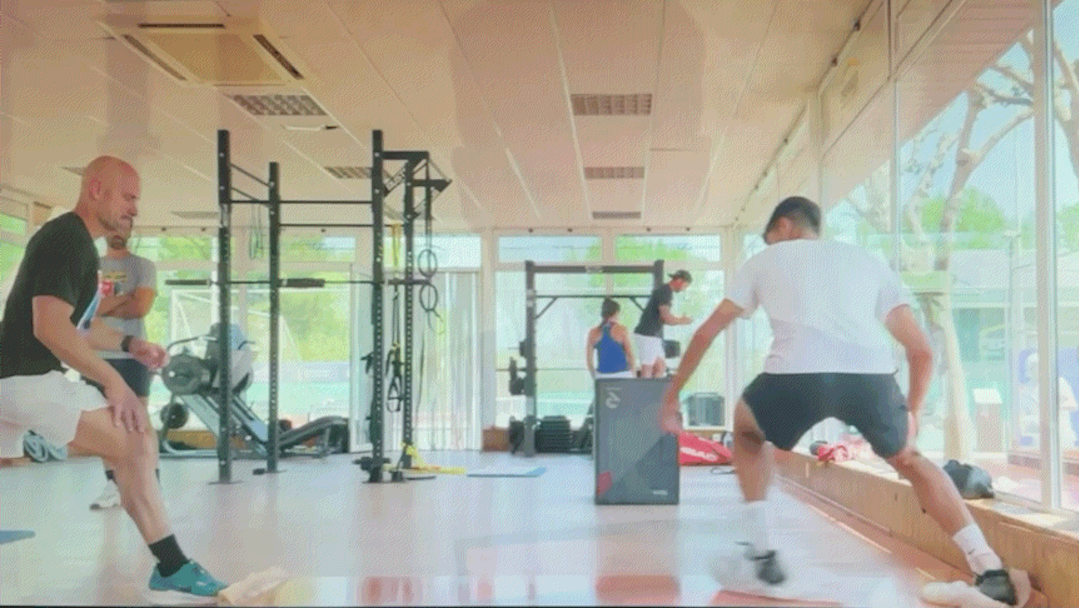Over the next several weeks the “Tennis Training and Technology” post each Tuesday will focus on techniques that made cameo appearances in the new Netflix documentary “Break Point.” These glimpses provide insight into the training methods that are woven into the fabric of the game at the elite levels. Most players who watched the show probably missed these learning opportunities.
While most of these exercises appear for only a couple of seconds, there is one activity that happens repeatedly throughout the first five episodes of the series. Players come off the court after their tournament matches and immediately hop on a stationary bike. In fact, this is where much of the post-match analysis occurs as depicted in the series. At one point, Taylor Fritz is even urgently prompted to hurry up and get on the bike as that discussion is occurring.
So why in the heck do professional tennis players almost immediately hop on a stationary bike after competing in tennis matches?
In short, using a stationary bike is one technique of “active recovery” after physical exertion. The practice isn’t unique to tennis and is widely used by professional hockey, basketball, and football teams. Pedaling against light resistance is believed to increase the flow of blood to the legs. In theory, that removes waste products and provides oxygen to the muscles. It is believed to reduce delayed onset muscle soreness.
The actual research on the efficacy of active recovery is mixed. Some studies have shown reduced muscle fatigue on the second day after the techniques were used. Other research did not reveal a clear benefit. However, a tennis-specific study published in 2020 concluded that tapered cooling strategies were effective for the alleviation of tennis training-induced soreness. Due to the widely perceived benefits, many elite tennis programs recommend the use of active recovery techniques. The practice is in widespread use at the elite levels.
Recreational players are unlikely to have immediate access to a stationary bike after playing at many facilities. However, light jogging or walking is a reasonable substitute that can work in most settings. The key is to find some low-impact movement to perform for a tapered cool-down interval. The duration of the cool-down period in the studies I examined varied from 5 to 30 minutes. From that data, I think that 15 minutes is a reasonable target time.
Based on my own observations, active cool-down may be one of the most underutilized techniques in recreational play. Of course, for league players who only play once a week, soreness a couple of days later might not matter. In fact, it might be heralded as a sign of courage and athleticism. The practice is definitely more relevant in tournament settings or for players who are intent on training at their highest levels throughout the week.
If you aren’t already habitually using active recovery techniques, this might be the time to give it a try.
- The Impact of Recovery Practices Adopted by Professional Tennis Players on Fatigue Markers According to Training Type Clusters, Mathilde Poignard et al, Frontiers in Sports and Active Living, September 2, 2020.
- Why do Hockey Players Ride a Stationary Bike After Games?, Ian Palmer, BSHockey.com, June 1, 2022.
- The Effect of Warm-Up and Cool-Down Exercise on Delayed Onset Muscle Soreness in the Quadriceps Muscle: a Randomized Controlled Trial, Olav Olsen et al, Journal of Human Kinetics, December 2012.
- Do We Need a Cool-Down After Exercise? A Narrative Review of the Psychophysiological Effects and the Effects on Performance, Injuries and the Long-Term Adaptive Response, Bas Van Hooren and Jonathan M. Peake, Sports Medicine, April 16, 2018.
- The Impact of Recovery Practices Adopted by Professional Tennis Players on Fatigue Markers According to Training Type Clusters, Mathilde Poignard et al, Frontiers in Sports and Active Living, September 2, 2020.



